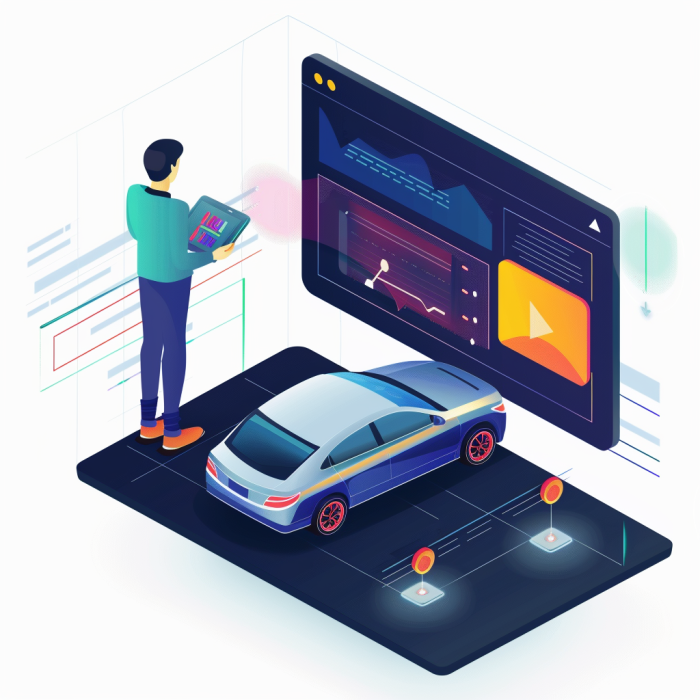In today’s rapidly advancing automotive industry, the car infotainment system has become an indispensable component of modern vehicles. Originally just a simple radio, this system has evolved into a sophisticated unit that integrates audio, navigation, connectivity, and even safety features. According to recent industry reports, nearly 80% of new vehicles sold globally are equipped with some form of infotainment system, underscoring its growing importance. This technology not only enhances the driving experience but also plays a critical role in vehicle safety and driver convenience.
For businesses in the automotive industry, especially those involved in fleet management and connected car services, investing in automotive infotainment systems is more than just a trend—it’s a strategic move. These systems offer advanced integration and interactive features that enhance driver experience, improve vehicle safety, and provide vital data for fleet management. Furthermore, with the rise of smartphone connectivity and digital technology, businesses can leverage these systems to improve operational efficiency and customer satisfaction.
In this article, we will explore the definition and key components of a car infotainment system, delve into the evolution of these systems in the automotive industry, and examine their impact on businesses. We’ll discuss how these systems work, their main functions, and the technology behind them. By the end of this article, you will have a comprehensive understanding of the car infotainment system and its significance in today’s connected vehicles.
- Automotive infotainment systems have evolved to provide entertainment, navigation, and communication features.
- Challenges include cybersecurity threats, user-friendliness, and driver safety.
- Collaborating with automotive software development specialists like Accelerate (a hypothetical company) can help automakers overcome challenges and create modern, safe, and user-friendly infotainment systems.
What is a Car Infotainment System?
A car infotainment system is an integrated system in a vehicle that provides a combination of information and entertainment services. This in-vehicle unit typically includes a display screen, control interfaces, an audio system, and connectivity modules. The touchscreen display is the central hub, allowing drivers and passengers to interact with various features such as navigation, audio controls, and smartphone integration. Control interfaces can include voice recognition, steering wheel controls, and physical buttons or dials. The audio system is not limited to radio; it encompasses advanced audio capabilities such as streaming, satellite radio, and high-fidelity sound. Connectivity modules are crucial for syncing with smartphones, accessing cloud services, and integrating with other digital systems within the vehicle.

Evolution of Infotainment Systems in the Automotive Industry
The evolution of the car infotainment system reflects the broader technological advancements in the automotive industry. Initially, vehicles had basic radio systems that only provided audio entertainment. However, as consumer demand for more convenience and connectivity grew, these systems began to evolve. The introduction of CD players and cassette tapes in the 1980s marked the first significant shift. By the late 1990s and early 2000s, navigation systems, and multi-function displays became standard in luxury vehicles. Today, the infotainment system has transformed into a comprehensive digital hub that integrates smartphone connectivity, navigation, entertainment, and even safety features such as driver assistance and collision alerts. This shift from basic entertainment to advanced multimedia systems has set the stage for the next generation of connected and autonomous vehicles.
How Does an Automotive Infotainment System Work?
User Interface and Experience
The user interface (UI) is the gateway through which drivers and passengers interact with the car infotainment system. Modern systems typically feature touchscreens that provide intuitive controls for navigation, audio, and vehicle functions. These screens are designed to minimize distraction, offering large, easy-to-read icons and responsive touch capabilities. In addition to touchscreens, many systems include voice control that allows users to execute commands hands-free. Advanced gesture recognition technology is also becoming more common, enabling users to control functions with simple hand movements. The goal of these interfaces is to provide a seamless, interactive experience that enhances the overall driving experience.
Connectivity Features
Connectivity is at the heart of modern infotainment systems. These systems are designed to sync effortlessly with smartphones, enabling drivers to access their apps, contacts, and music libraries directly from the infotainment screen. Bluetooth technology is commonly used for wireless audio streaming and hands-free calling, while Wi-Fi and cellular connectivity enable internet access for real-time updates and online services. Apple CarPlay and Android Auto are popular integrations that allow users to mirror their smartphone’s interface on the vehicle’s display screen, providing access to navigation, messaging, and entertainment apps. This connectivity transforms the car infotainment system into a central hub for all digital needs while on the road.
Navigation and Real-time Information
One of the core features of a car infotainment system is its navigation capability. These systems utilize GPS technology to provide accurate and reliable route guidance. Advanced navigation systems offer real-time traffic updates, helping drivers avoid congestion and find the quickest routes to their destination. Some systems also integrate with other driving aids like lane departure warnings and adaptive cruise control, to provide a safer driving experience. Integrating navigation with the infotainment system ensures that drivers have access to the most up-to-date information, making it easier to navigate even in unfamiliar areas.
Entertainment and Media
Entertainment is a major component of the car infotainment system. Drivers and passengers can enjoy a wide range of audio options, from traditional AM/FM radio to streaming services like Spotify and Pandora. Video playback capabilities allow for watching movies or TV shows on rear-seat screens, making long trips more enjoyable. Some systems even support gaming, turning the vehicle into a mobile entertainment center. With the ability to customize playlists, stream live content, and even download podcasts, the entertainment experience in modern vehicles is more immersive and convenient than ever.
Safety and Assistance Systems
Safety is a critical aspect of automotive infotainment systems. These systems are increasingly integrated with various safety features to enhance driver assistance and accident prevention. For instance, rear-view cameras display live images on the infotainment screen to assist with parking and reversing. Parking sensors provide audio and visual alerts to help avoid obstacles. Advanced Driver Assistance Systems (ADAS) like automatic emergency braking, lane-keeping assist, and adaptive cruise control are often linked to the infotainment system, allowing for seamless control and monitoring. These integrations make the car infotainment system not only a source of entertainment but also a crucial component in ensuring the safety of the vehicle and its occupants.
Vehicle Data Integration
Modern car infotainment systems are designed to interact with the vehicle’s internal systems, providing real-time data on various aspects of vehicle performance. This includes fuel efficiency, tire pressure, engine diagnostics, and more. This integration allows drivers to monitor their vehicle’s health and receive alerts for necessary maintenance, all through the infotainment interface. Additionally, this data can be shared with service centers or fleet managers, ensuring that vehicles are operating optimally and that any issues are addressed promptly.
Operating Systems
The backbone of any car infotainment system is its operating system (OS). These systems run on specialized automotive platforms that are designed to be reliable, fast, and capable of handling multiple tasks simultaneously. Some of the popular operating systems in this domain include Android Automotive OS, QNX, and custom Linux-based systems. The OS manages everything from the user interface to connectivity, navigation, and vehicle data processing, ensuring that all components of the infotainment system work together seamlessly.
Do you need Automotive Software Development?
Contact usWhy Big Businesses Should Invest in Automotive Infotainment Systems
- Enhancing Customer Experience: Investing in advanced infotainment systems is crucial for businesses aiming to enhance customer experience. These systems offer a wide array of features that improve driving comfort and convenience, such as personalized entertainment options, seamless smartphone integration, and real-time navigation assistance. By providing a superior in-car experience, businesses can boost customer satisfaction and foster brand loyalty. In the competitive automotive market, a well-designed infotainment system can be the key differentiator that keeps customers coming back.
- Differentiation in a Competitive Market: In a crowded automotive market, standing out is essential. Cutting-edge infotainment systems provide a unique selling point that can differentiate a brand from its competitors. Whether through innovative user interfaces, enhanced connectivity options, or integrated safety features, these systems can make a significant impact on how a vehicle is perceived. For manufacturers and fleet operators, offering an advanced infotainment system can attract tech-savvy customers and position the brand as a leader in modern vehicle technology.
- Revenue Streams and Upselling Opportunities: Infotainment systems open up new avenues for revenue generation. Businesses can offer premium features such as subscription-based services for live traffic updates, in-car entertainment, and remote diagnostics. Additionally, there are opportunities for upselling hardware upgrades, such as larger displays, enhanced audio systems, or advanced navigation packages. By leveraging the versatility of infotainment systems, businesses can create additional revenue streams and increase profitability.
- Data Collection and Analytics: One of the most valuable aspects of modern infotainment systems is their ability to collect and analyze data. These systems can track user preferences, driving habits, and vehicle performance, providing businesses with insights that can drive future product development and marketing strategies. By analyzing this data, companies can better understand their customers’ needs and tailor their offerings to meet those demands. This data-driven approach can lead to more effective business decisions and a stronger competitive edge.
- Integration with Connected Car Services: Infotainment systems are a crucial component of the broader connected car ecosystem. They work in tandem with other connected services such as fleet management, telematics, and remote diagnostics. For businesses, this integration provides a comprehensive solution that enhances vehicle management, improves operational efficiency, and delivers a superior experience to end-users. As the industry moves towards more connected and autonomous vehicles, having a robust infotainment system will be essential for staying competitive and delivering cutting-edge services.
Key Characteristics of Car Infotainment System
- Wireless Connectivity: Modern car infotainment systems come with wireless connectivity features such as Bluetooth and Wi-Fi, allowing seamless connection between the vehicle and other devices. This feature enables hands-free calling, wireless audio streaming, and internet access for a more connected driving experience.
- Voice Assistance: Voice assistance is a significant component of infotainment systems, enabling drivers to control various functions without taking their hands off the wheel. This includes making calls, setting navigation routes, and adjusting the climate control, all through simple voice commands.
- Real-time Route Assistance: Real-time route assistance provides drivers with up-to-date traffic information, alternative routes, and estimated arrival times. This feature helps in avoiding traffic congestion and ensures a smooth and timely journey.
- Auto Park Assistance: Auto Park Assistance is an advanced feature integrated into some infotainment systems that aid drivers in parking their vehicles. This system uses sensors and cameras to detect suitable parking spaces and can even autonomously steer the vehicle into the spot, making parking safer and more convenient.
- Artificial Intelligence: Artificial Intelligence (AI) is increasingly being incorporated into car infotainment systems to provide a more personalized and intuitive user experience. AI can learn user preferences, predict routes, and even offer suggestions for nearby services based on the driver’s habits and previous choices.
Challenges of Car Infotainment System
While car infotainment systems offer numerous benefits, they also come with certain challenges. These include:
- Risk of driver distraction
- Complexity of software updates
- Compatibility issues with various devices
- Potential cybersecurity vulnerabilities
How is the Car Infotainment System Built?
Building a car infotainment system is a complex process that involves several stages, each integrating various hardware and software components. Here’s an overview of how these systems are built:
- Conceptualization and Design:
- Market Research and Requirements Gathering: The process begins with understanding customer needs, industry trends, and regulatory requirements. This helps in defining the features and capabilities of the infotainment system.
- System Architecture Design: Engineers design the overall architecture of the system, including the hardware layout, software frameworks, and communication protocols. This includes decisions on the type of display, processing power, connectivity options, and user interface.
- Hardware Development:
- Selection of Components: The hardware components such as the central processing unit (CPU), graphics processing unit (GPU), memory, touchscreens, speakers, and connectivity modules (e.g., Bluetooth, Wi-Fi, GPS) are selected based on the system’s requirements.
- Prototype Development: Engineers create prototypes to test the hardware configuration. These prototypes help identify issues with component compatibility, heat management, and overall performance.
- Software Development:
- Operating System and Middleware: A suitable operating system (e.g., Linux, Android Automotive) is selected, and middleware is developed to manage communication between the hardware and the application layer.
- User Interface (UI) Design: The UI is designed to be intuitive and user-friendly. This includes touch gestures, voice commands, and other interactive elements. The design is often tested through user experience (UX) studies to ensure it meets user expectations.
- Application Development: Applications such as navigation, media playback, smartphone integration, and vehicle diagnostics are developed. These apps must be optimized to run smoothly on the system’s hardware.
- Integration and Testing:
- Hardware-Software Integration: The hardware and software components are integrated, ensuring that they work seamlessly together. This includes making sure the system can interact with the car’s other electronic systems, such as the engine control unit (ECU) and sensors.
- Testing: Extensive testing is conducted to ensure the system is reliable and safe. This includes functional testing, stress testing, and real-world testing in vehicles. Security testing is also critical to protect against potential cyber threats.
- Certification and Compliance:
- Regulatory Compliance: The system must meet various regulatory standards, including those related to safety, electromagnetic compatibility (EMC), and data privacy. The system undergoes certification processes to ensure it meets these standards.
- OEM Validation: If the system is being developed for an original equipment manufacturer (OEM), it must pass the OEM’s validation process. This includes ensuring the system meets the carmaker’s specific requirements and quality standards.
- Production and Deployment:
- Manufacturing: Once the system design is finalized, it moves to mass production. This involves the manufacturing of hardware components, assembly, and pre-installation of software.
- Integration into Vehicles: The infotainment system is then integrated into the vehicles during the manufacturing process. This step may also involve final testing to ensure the system functions correctly in the specific vehicle model.
- Post-Production Support: After deployment, the system requires ongoing support, including software updates, troubleshooting, and addressing any issues that arise in the field.
Each of these stages requires collaboration between hardware engineers, software developers, UX/UI designers, cybersecurity experts, and automotive engineers to ensure the system is robust, secure, and user-friendly.
The Future of Car Infotainment Systems
The future of car infotainment systems is poised to be even more integrated and advanced. With the rise of autonomous vehicles, these systems will likely take on a more central role, offering not just entertainment and navigation, but also control over more aspects of the vehicle’s operations. We can also have tailored experiences. Additionally, as 5G connectivity becomes more widespread, infotainment systems will benefit from faster data transfer rates, enabling real-time updates and more interactive features. Augmented Reality (AR) is also expected to play a significant role in future infotainment systems, providing heads-up displays with navigation information directly on the windshield or enhancing safety by highlighting potential hazards on the road.
Electric vehicles (EVs) and the push towards more sustainable transportation will likely drive innovations in infotainment systems as well. These systems may offer enhanced energy management features, such as monitoring battery levels and optimizing routes to include charging stations. As vehicles become more connected, the ability to remotely control and monitor the vehicle through the infotainment system will also expand, offering new conveniences for users.
The evolution of infotainment systems will continue to shape the automotive experience, turning vehicles into smarter, more interactive environments that cater to both drivers and passengers.
Final Thoughts
The automotive infotainment system has evolved from simple radio setups to sophisticated digital ecosystems that significantly enhance the driving experience. These systems now seamlessly integrate navigation, entertainment, and safety features, making them indispensable in modern vehicles. As technology continues to advance, the future of infotainment systems promises even greater connectivity, convenience, and personalization. For businesses, staying ahead by investing in the latest infotainment systems isn’t just about keeping pace—it’s about delivering a superior product that caters to the ever-changing needs of today’s drivers.For companies looking to lead the way in infotainment technology, Ficus Technologies offers cutting-edge expertise and innovative solutions to accelerate the development of advanced automotive infotainment software. Whether you’re seeking custom solutions tailored to specific manufacturer requirements or scalable platforms for rapid deployment, Ficus Technologies is poised to shape the future of automotive infotainment systems. For more detailed information, contact Ficus Technologies.
Infotainment systems integrate with connected car services by enabling real-time communication between the vehicle and external services. This includes features like remote vehicle monitoring, telematics, over-the-air updates, and integration with apps that provide navigation, entertainment, and safety functionalities.
The purpose of an infotainment system is to enhance the driving experience by providing a combination of entertainment, information, and connectivity within the vehicle. It allows drivers and passengers to access media, navigation, communication, and vehicle control features through a central interface.
An infotainment system is a comprehensive digital hub that combines multiple functions, including audio, video, navigation, and connectivity. In contrast, a stereo system traditionally refers to the audio component that plays music or radio in the car. While stereos are a part of infotainment systems, infotainment encompasses much more, offering a wide range of interactive features.
The best car infotainment systems are typically found in luxury vehicles and are known for their advanced features, user-friendly interfaces, and seamless integration with smartphones and other devices. Some top-rated systems include Audi’s MMI, BMW’s iDrive, Mercedes-Benz’s MBUX, and Tesla’s touchscreen interface, which all offer a blend of high-tech functionality and intuitive controls.









This article provides a comprehensive overview of automotive infotainment software development, emphasizing its critical role in modern vehicles. It elucidates how infotainment systems enhance entertainment, navigation, and communication. Addressing challenges such as cybersecurity and user-friendliness underscores the importance of partnering with experts like Accelerate for cutting-edge, safe, and user-friendly infotainment solutions in the ever-evolving automotive industry.
Automotive infotainment software development is the focal point of this informative article. It underscores the expanding role of infotainment systems in vehicles, encompassing entertainment, navigation, and communication functions. The article emphasizes the significance of collaborating with experienced specialists like Accelerate to create innovative and secure infotainment solutions by addressing cybersecurity, usability, and driver safety challenges.
The autor offers a comprehensive insight into the evolving world of automotive infotainment software development. It highlights the growing importance of infotainment systems in modern vehicles, catering to entertainment, navigation, and communication needs. The mention of cybersecurity challenges and the need for user-friendliness and safety provides valuable context. Collaborating with specialists like Accelerate is presented as a solution for creating cutting-edge infotainment systems.